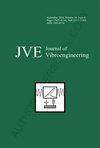Ship shafting alignment technology and hull deformation based on improved genetic algorithm and shipbed calibration
IF 0.7
Q4 ENGINEERING, MECHANICAL
引用次数: 0
Abstract
As science and technology develop in recent years, the center of ship shafting has received high attention from the ship industry. The traditional ship shafting calibration mostly focuses on the issue that hull deformation cannot be accurately estimated. The ship is floating after entering the water, and this method is not conducive to the long-term stable operation of the ship shafting. To solve the above problems, the study establishes the optimization model of ship axis alignment based on slide alignment and finite element method. This model can be optimized by adopting the non-dominant sequencing genetic algorithm improved by elite strategy. The study verified the performance of the optimization model of ship axis alignment. The results showed that the adaptive value, super-volume value, and inverse generation distance of the improved genetic algorithm were 74.57, 0.38, and 0.03, respectively. In the application of a ship, the intermediate bearing position could be adjusted by the ship shafting optimization model based on the improved non-dominant sorting genetic algorithm. As a result, the shaft reaction under the ballast condition was reduced by 24019 N than before, making the bearing load of the ship shafting more uniform. To sum up, the proposed optimal model is robust, which can effectively reduce the impact of hull deformation, improve the optimal effect of ship shafting alignment and ensure the safe navigation of the ship.基于改进遗传算法和船台校准的船舶轴系对准技术和船体变形
随着近年来科学技术的发展,船舶轴系中心受到了船舶行业的高度重视。传统的船舶轴系校核大多集中在船体变形无法准确估计的问题上。船舶入水后处于漂浮状态,这种方法不利于船舶轴系的长期稳定运行。为解决上述问题,本研究建立了基于滑动对中和有限元法的船轴对中优化模型。该模型可采用经精英策略改进的非优势排序遗传算法进行优化。研究验证了船轴对中优化模型的性能。结果表明,改进遗传算法的自适应值、超容值和逆生成距离分别为 74.57、0.38 和 0.03。在船舶应用中,基于改进的非优势排序遗传算法的船舶轴系优化模型可以调整中间轴承位置。结果,压载条件下的轴反力比以前减少了 24019 N,使船轴承的承载负荷更加均匀。综上所述,所提出的优化模型具有良好的鲁棒性,能有效降低船体变形的影响,提高船轴对中的优化效果,确保船舶的安全航行。
本文章由计算机程序翻译,如有差异,请以英文原文为准。
求助全文
约1分钟内获得全文
求助全文
来源期刊

Journal of Vibroengineering
工程技术-工程:机械
CiteScore
1.70
自引率
0.00%
发文量
97
审稿时长
4.5 months
期刊介绍:
Journal of VIBROENGINEERING (JVE) ISSN 1392-8716 is a prestigious peer reviewed International Journal specializing in theoretical and practical aspects of Vibration Engineering. It is indexed in ESCI and other major databases. Published every 1.5 months (8 times yearly), the journal attracts attention from the International Engineering Community.
 求助内容:
求助内容: 应助结果提醒方式:
应助结果提醒方式:


